Category: Archives
Saturday Poem
I Was Never One
of those matter-
of-fact mothers,
who tell their children
this is thus or what
to do. Though I knew
how to hold my babies
as soon as they were
handed to me, I could feel
how tremulous life was.
This animal cradled on my heart, mine
for the naming, how was I to guess
at what it wanted?
Milk, Yes. Love, yes. To lie on
me and sleep—yes, yes. But
what I wanted to know
about my babies stitched back
to what I’d been
when I was young—
to what I wanted—
and I couldn’t remember that.
Sometimes, under my baby—
me a boulder, she a lion—
I’d feel our hearts beat
not as one, but stranger
still, as two hearts
pulsing through what
came between them—two
sets of ribs, two muscle walls, two
layers of skin. That I had pushed
my daughters from the dark
unknown of my own
body—I never
got over that.
by Trish Crapo
from Walk Through Paradise Backward
Slate Roof Publishing Collective, 2004
How Tariq Trotter of the Roots built a life-affirming philosophy
Erik Gleiberman in The Washington Post:
Trotter forgoes the narrative many readers might expect, an inside account of a career leading to what I consider the most visionary and musically rich act in hip-hop history. Though he briefly explores the high school origins of his creative alchemy with co-frontman Ahmir Thompson (a.k.a. Questlove), Trotter does not discuss a single Roots song. Instead, he’s out to reconstruct his “communally built self,” honoring the many family members who strove to nurture a young man with artistic promise, while their own lives often fell prey to the destructive forces that besieged South Philadelphia in the 1980s and ’90s.
More here.
A pilgrimage year: Iraq
Atish Taseer in The New York Times:
 GRIEF, MEMORY, LOVE. I had not planned for this trinity of themes to become the substratum of my pilgrimage. Yet six months on, to arrive in Iraq in the nights leading up to Ashura — the climactic 10th day in a ritual period of mourning for the world’s more than 150 million Shiite Muslims — was to be confronted by a grief so fresh that the event that inspired it, the martyrdom of the Prophet Muhammad’s grandson Hussein in 680, might have occurred yesterday.
GRIEF, MEMORY, LOVE. I had not planned for this trinity of themes to become the substratum of my pilgrimage. Yet six months on, to arrive in Iraq in the nights leading up to Ashura — the climactic 10th day in a ritual period of mourning for the world’s more than 150 million Shiite Muslims — was to be confronted by a grief so fresh that the event that inspired it, the martyrdom of the Prophet Muhammad’s grandson Hussein in 680, might have occurred yesterday.
To be Shiite was to live with the pain, never more acute than at Ashura, of not having been there for Hussein when it mattered most. In 680, Hussein had hearkened to the call of Muslims in the garrison town of Kufa, a few miles east of Najaf. His grandfather the Prophet had been dead for less than 50 years. In that time, the small community of believers had grown into the vast Arab Muslim empire. Hussein’s father, Ali — the Prophet’s beloved son-in-law and cousin — was the last of the four Rashidun (“rightly guided”) caliphs until he died in 661 at the hands of an assassin who struck him with a poisoned sword as he prayed. The Shiat Ali (Partisans of Ali) were at first merely his followers, people who believed that the mantle of the Prophet could only be assumed by one of his bloodline. So when, in 680, Muawiya, the first caliph since Ali, died and the caliphate passed to his dissolute son, Yazid, the Shiat Ali implored Hussein to take his rightful place at the head of Islam.
More here.
Friday, November 17, 2023
Rethinking the Modern Corporation
Michael Lind in The Hedgehog Review:
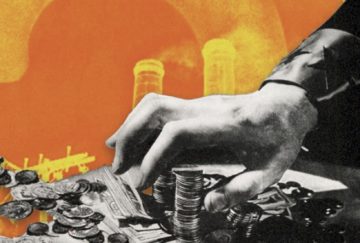 Americans of the left, right, and center are increasingly hostile to big corporations—but not for the same reasons. Many on the left are deeply uncomfortable with capitalism as such—that is to say, with corporate profit. In contrast, the populist right has turned against “woke” corporations that support transgender ideology, affirmative action, and other public policies conservatives oppose. But this is an objection not to corporate profit but to particular exercises of corporate power. Finally, as a response to US deindustrialization and the rise of China’s industrial and military power, there is growing bipartisan support for economic nationalism and industrial policy, particularly among national security experts in both parties. Here the criticism involves corporate purpose: Should American corporations, by investing or manufacturing in China, build up the economy of a country that is increasingly seen as America’s major rival in the world?
Americans of the left, right, and center are increasingly hostile to big corporations—but not for the same reasons. Many on the left are deeply uncomfortable with capitalism as such—that is to say, with corporate profit. In contrast, the populist right has turned against “woke” corporations that support transgender ideology, affirmative action, and other public policies conservatives oppose. But this is an objection not to corporate profit but to particular exercises of corporate power. Finally, as a response to US deindustrialization and the rise of China’s industrial and military power, there is growing bipartisan support for economic nationalism and industrial policy, particularly among national security experts in both parties. Here the criticism involves corporate purpose: Should American corporations, by investing or manufacturing in China, build up the economy of a country that is increasingly seen as America’s major rival in the world?
More here.
Assembling Robert Rauschenberg’s Studio
Ian Volner at Artforum:
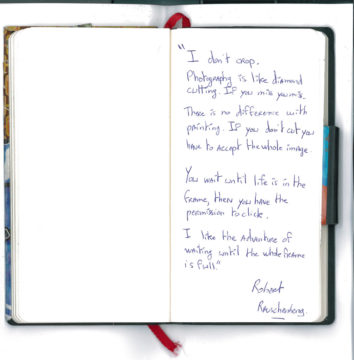 From 1965 to 1970, Robert Rauschenberg made the building his personal and professional HQ, a place to live, work, and (if the story be true) provide surplus shellfish to whomever asked. “I think the house satisfied a mix of aesthetic necessities and social desires for him,” says Kathy Halbreich, lately the executive director of and now an adviser to the Robert Rauschenberg Foundation. Since 1970, when the artist departed for roomier digs in Captiva, Florida, his eponymous organization has kept its offices in the building, remaining there even after Rauschenberg himself died in 2008 and well after bohemia had largely decamped from the neighborhood today known as NoHo. Tucked between a parking lot and the home of the New York University bursar, the five-story, redbrick, round-arch-style structure hides in plain sight, its anonymity somewhat abetted by the foundation’s low profile. “We’ve never really wanted to trumpet our location,” says Halbreich.
From 1965 to 1970, Robert Rauschenberg made the building his personal and professional HQ, a place to live, work, and (if the story be true) provide surplus shellfish to whomever asked. “I think the house satisfied a mix of aesthetic necessities and social desires for him,” says Kathy Halbreich, lately the executive director of and now an adviser to the Robert Rauschenberg Foundation. Since 1970, when the artist departed for roomier digs in Captiva, Florida, his eponymous organization has kept its offices in the building, remaining there even after Rauschenberg himself died in 2008 and well after bohemia had largely decamped from the neighborhood today known as NoHo. Tucked between a parking lot and the home of the New York University bursar, the five-story, redbrick, round-arch-style structure hides in plain sight, its anonymity somewhat abetted by the foundation’s low profile. “We’ve never really wanted to trumpet our location,” says Halbreich.
more here.
How To SEE Robert Rauschenberg with Sarah Sze
Dancing monkey hormones shed light on harmful street shows in Pakistan
Christa Lesté-Lasserre in New Scientist:
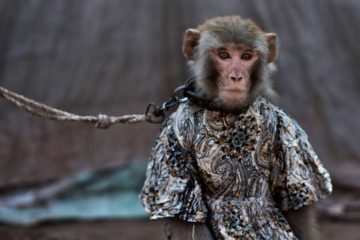 Monkeys that “dance” in street shows in Pakistan have high levels of stress hormones, abnormal behaviour and poor health – but stopping such shows would create a welfare crisis for trainers and their families, researchers say.
Monkeys that “dance” in street shows in Pakistan have high levels of stress hormones, abnormal behaviour and poor health – but stopping such shows would create a welfare crisis for trainers and their families, researchers say.
Taken from the wild as infants, rhesus macaques are kept by travelling trainers throughout South and South-East Asia and made to perform dance steps, tricks and acrobatics on short leashes. While some audiences find the performances “cute” and “funny”, hair analyses have confirmed that the animals live with constant and dangerous levels of stress.
The findings underline the cruel reality of a trade based on hierarchical trade groups that keep both the monkeys and their low-income trainers in difficult circumstances, says Mishaal Akbar at the University of Glasgow, UK.
More here.
Rubens And Body Positivity
Michael Prodger at The New Statesman:
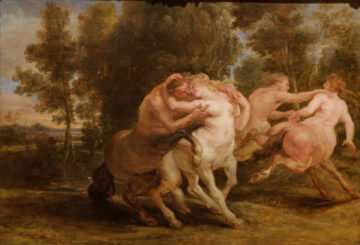 Peter Paul Rubens, known in his lifetime as “the prince of painters and the painter of princes”, is not, perhaps, a figure sympathetic to the modern age. He was by all accounts a charming man with graceful manners who could speak Latin, Dutch, Italian, Spanish, French and German; he was knighted by both Philip IV of Spain and Charles I of England; and employed as a diplomat and spy as well as a painter; he was a man as comfortable in Europe’s courts as in his studio. As such, he is just a tad too smooth when contemporary tastes run to artists with a bit of grit in the oyster.
Peter Paul Rubens, known in his lifetime as “the prince of painters and the painter of princes”, is not, perhaps, a figure sympathetic to the modern age. He was by all accounts a charming man with graceful manners who could speak Latin, Dutch, Italian, Spanish, French and German; he was knighted by both Philip IV of Spain and Charles I of England; and employed as a diplomat and spy as well as a painter; he was a man as comfortable in Europe’s courts as in his studio. As such, he is just a tad too smooth when contemporary tastes run to artists with a bit of grit in the oyster.
What is more, as the pre-eminent painter of Catholicism he has never been embraced on these shores, and nor has the drama and movement of the baroque style, with which he was inextricably tied and of which he was the greatest exponent. Meanwhile, his supposed attitude towards women – their fleshy amplitude characterised as “Rubensian” – is not just out of favour but frowned on.
more here.
Elon Musk and the Value of Failure
Virginia Postrel in The Washington Free Beacon:
 For its first two-thirds, Walter Isaacson’s mammoth biography of Elon Musk is an epic romance, like The Lord of the Rings (a Musk favorite) or the Arthurian legends. It portrays the hero and his comrades overcoming seemingly insurmountable obstacles through daring, determination, cleverness, and skill, all in the pursuit of noble goals.
For its first two-thirds, Walter Isaacson’s mammoth biography of Elon Musk is an epic romance, like The Lord of the Rings (a Musk favorite) or the Arthurian legends. It portrays the hero and his comrades overcoming seemingly insurmountable obstacles through daring, determination, cleverness, and skill, all in the pursuit of noble goals.
The critical moment in that tale comes in 2008, which Musk described to Isaacson as “the most painful year of my life.” His marriage broke up. One after another, the first three SpaceX rockets exploded before reaching orbit. The first Tesla Roadsters came off the line, but only with hand fitting at an exorbitant and unsustainable cost. He ran out of money. His audacious ventures appeared doomed. Everyone told Musk that his best chance was to try to save one company and let the other go out of business. But he refused to choose between Tesla and SpaceX.
More here.
Stop Making Sense: The Most Neurodivergent Concert Film Ever Made
Loved, yet lonely
Kaitlyn Creasy in aeon:
 Although one of the loneliest moments of my life happened more than 15 years ago, I still remember its uniquely painful sting. I had just arrived back home from a study abroad semester in Italy. During my stay in Florence, my Italian had advanced to the point where I was dreaming in the language. I had also developed intellectual interests in Italian futurism, Dada, and Russian absurdism – interests not entirely deriving from a crush on the professor who taught a course on those topics – as well as the love sonnets of Dante and Petrarch (conceivably also related to that crush). I left my semester abroad feeling as many students likely do: transformed not only intellectually but emotionally. My picture of the world was complicated, my very experience of that world richer, more nuanced.
Although one of the loneliest moments of my life happened more than 15 years ago, I still remember its uniquely painful sting. I had just arrived back home from a study abroad semester in Italy. During my stay in Florence, my Italian had advanced to the point where I was dreaming in the language. I had also developed intellectual interests in Italian futurism, Dada, and Russian absurdism – interests not entirely deriving from a crush on the professor who taught a course on those topics – as well as the love sonnets of Dante and Petrarch (conceivably also related to that crush). I left my semester abroad feeling as many students likely do: transformed not only intellectually but emotionally. My picture of the world was complicated, my very experience of that world richer, more nuanced.
After that semester, I returned home to a small working-class town in New Jersey. Home proper was my boyfriend’s parents’ home, which was in the process of foreclosure but not yet taken by the bank. Both parents had left to live elsewhere, and they graciously allowed me to stay there with my boyfriend, his sister and her boyfriend during college breaks. While on break from school, I spent most of my time with these de facto roommates and a handful of my dearest childhood friends.
More here.
Why Do Fingers Prune?
Danielle Gerhard in The Scientist:
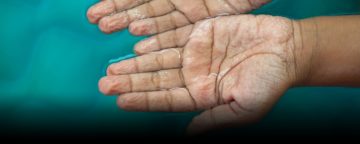 Why fingers shrivel up in water is an age-old question that every child asks at bath time, but the answer may come as a surprise. “The whole body doesn’t wrinkle, and that says a lot,” said Einar Wilder-Smith, a neurologist at Luzerner Kantonsspital. Unlike the surrounding skin, the outermost layer of the fingertip is highly innervated with and tethered to vasculature, setting the stage for pruney fingers.
Why fingers shrivel up in water is an age-old question that every child asks at bath time, but the answer may come as a surprise. “The whole body doesn’t wrinkle, and that says a lot,” said Einar Wilder-Smith, a neurologist at Luzerner Kantonsspital. Unlike the surrounding skin, the outermost layer of the fingertip is highly innervated with and tethered to vasculature, setting the stage for pruney fingers.
While osmosis, particularly into dead skin cells, seems like a compelling explanation for this curious phenomenon, Wilder-Smith clarified, “In fact, it’s the opposite.”
In the early 2000s, while working at the National University Hospital in Singapore, Wilder-Smith suspected that the surrounding vasculature drives the wrinkling. He found that after a long soak, blood vessels nestled just below the skin constrict, resulting in negative pressure and downward tugging of the outermost layer of skin. The uneven puckering pattern likely results from varied skin tautness, or tethering, throughout the fingertip.
More here.
Friday Poem
The Engine Cowling
Let engine cowling rivets
………. adhere. Let hydraulic systems operate
flaps without interruption
………. and electrical signals work as expected
O 747
………. that carries Glaucus across the Atlantic
and slants down over the brief
………. Mediterranean to the Grecian shore,
Keep him safe. Not long ago
………. flying required noticeable bravery
as a bold Frenchman, not to
………. say Dayton Ohio’s bicycle-making
brothers, ascended on frail
………. boxes into an alien windstream, never
questioning propriety
………. but taking on challenge as their domain.
When their eyes teared with the wind,
………. did they fear wind? Although they climbed the breezes
of our own century, they
………. seem ancient as Leonardo or Fulton.
They were gallant without guilt
………. as they rose up, and expected to return —
after ingenuity
………. and courage sustained them their moment of release
from the ponderable weight
………. of gravity — to accept the gratitude
of their descendants. But they
………. prepared us Dresden’s fire and Nagasaki’s.
Are we grateful for the death
………. that drops on us from flying mental engines
the Renaissance invented
………. with enlightened conceit? If we beg pardon,
as we dig holes for ourselves,
………. all right; but if we ascend, separated
from grief’s ground without terror
………. or foreboding, we add complacency to
wickedness, idiocy,
………. and engineering. Fear death. Anxiety
mothers and fathers souls
………. giddy with vacuum — otherwise orphaned.
by Donald Hall
from The Museum of Clear Ideas
Ticknor & Fields, 1993
Thursday, November 16, 2023
What’s on Top of TikTok?
Tess McNulty at Public Books:
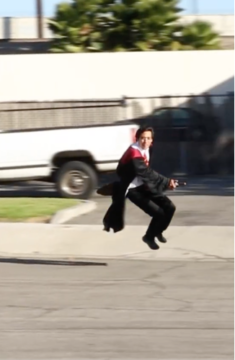 First, watch this very brief video. Or, if you prefer, read this description: For five seconds, an adult man, dressed up as the boy-wizard Harry Potter, appears to fly through the air on a broomstick, while twinkly music plays (a parodic riff on the Potterverse theme). Next, he exposes the ostensible mechanism behind his illusion: a contraption (concealed beneath his midsection) involving a mirror, a prosthetic leg, and a longboard. Finally, he engages with his cameraman in a verbal, slapstick squabble over who owns the longboard. “Come back here!” the cameraman yells, while the faux-wizard rolls away.
First, watch this very brief video. Or, if you prefer, read this description: For five seconds, an adult man, dressed up as the boy-wizard Harry Potter, appears to fly through the air on a broomstick, while twinkly music plays (a parodic riff on the Potterverse theme). Next, he exposes the ostensible mechanism behind his illusion: a contraption (concealed beneath his midsection) involving a mirror, a prosthetic leg, and a longboard. Finally, he engages with his cameraman in a verbal, slapstick squabble over who owns the longboard. “Come back here!” the cameraman yells, while the faux-wizard rolls away.
The sequence, at only 18 seconds long, is almost vanishingly slight. Yet it has done anything but escape notice. According to multiple sources, “Zach King’s Magic Ride”—as it is sometimes called—which was first posted to TikTok on December 9, 2019, is currently the “Most Viewed TikTok of all Time.” That makes it, arguably, one of the most visible new aesthetic creations in the contemporary world.
More here.
In India, a Need for New Antidotes to Curb Deadly Snakebites
Kamala Thiagarajan in Undark:
 According to the Million Death Study, one of the largest ongoing global studies of premature mortality, around 58,000 Indians die from snakebites every year, the highest rate in the world. And a growing proportion of these bites come from less common species of venomous snakes in specific pockets of the country, for which, according to researchers at the Indian Institute of Science, available antivenin — also often called antivenom — are not very effective.
According to the Million Death Study, one of the largest ongoing global studies of premature mortality, around 58,000 Indians die from snakebites every year, the highest rate in the world. And a growing proportion of these bites come from less common species of venomous snakes in specific pockets of the country, for which, according to researchers at the Indian Institute of Science, available antivenin — also often called antivenom — are not very effective.
People living in India’s rural areas, who are exposed to a broad range of snakes, are particularly at risk. Treating these patients can be difficult, said Gnaneswar Ch, project leader of the Snake Conservation & Snakebite Mitigation Project at the Madras Crocodile Bank Trust Center for Herpetology, where the Irula Co-op is located.
For instance, in Tamil Nadu, data on snakebites and how to prevent them — gathered by Gnaneswar’s team since 2015 — suggest that people are most likely to be bitten on their legs when they walk across agricultural fields barefoot. And they may not seek treatment at the hospital until hours after the bite, turning first to natural or folk remedies. As a result, Gnaneswar said, “we’re seeing many amputations and loss of limbs.”
More here.
Secularism in Iran
Patrick Hassan in Aeon:
 The latest waves of uprisings in Iran following the movement in defence of Iranian women’s freedoms are among the most significant since the Islamic Republic was established after the overthrow of Mohammad Reza Pahlavi in 1979. The regime’s resulting crackdown has led to mass arrests and prison sentences, as well as a string of executions. These uprisings are symptomatic of prolonged and multifaceted discontent with the Islamic Republic’s perceived governance. One of the oft-cited causes is growing dissatisfaction with principles of government grounded in a religious worldview, and its subsequent patterns of civil liberty violations. The most visible of these violations, which has served as a focal point for resistance, is the law of mandatory hijab for women.
The latest waves of uprisings in Iran following the movement in defence of Iranian women’s freedoms are among the most significant since the Islamic Republic was established after the overthrow of Mohammad Reza Pahlavi in 1979. The regime’s resulting crackdown has led to mass arrests and prison sentences, as well as a string of executions. These uprisings are symptomatic of prolonged and multifaceted discontent with the Islamic Republic’s perceived governance. One of the oft-cited causes is growing dissatisfaction with principles of government grounded in a religious worldview, and its subsequent patterns of civil liberty violations. The most visible of these violations, which has served as a focal point for resistance, is the law of mandatory hijab for women.
Gathering reliable empirical data on religious belief in Iran is difficult – apostasy (at least from Islam) is illegal and punishable by death under the vaguely defined crime of Ifsad-e-filarz, or ‘corruption on Earth’. Nevertheless, some available evidence from 2020 suggests predominant opposition to mandatory hijab, to the extent that even some hijabi women have joined the protests to defend everyone’s equal right to liberty. More recent evidence from 2022 also suggests a significant favourable shift towards secularism broadly, with the majority in favour of a separation of religious and civil affairs. Some contemporary research has suggested that, ironically, Iranian theocracy has triggered these trends, which have naturally raised the question of the role of religion in Iranian society.
More here.
What The Longest-Running Study on Happiness Reveals
Selfless Minds: A Contemporary Perspective on Vasubandhu’s Metaphysics
Jay L Garfield at Notre Dame Philosophical Reviews:
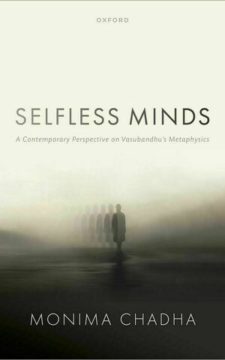 Monima Chadha has given the world of Anglophone philosophy more reason to take Indian Buddhist philosophy seriously in this closely argued study of the philosophy of the 4th century philosopher Vasubandhu, generally regarded as one of the founders (with his older brother Asaṅga) of the Yogācāra tradition, a tradition associated sometimes with idealism, and sometimes with phenomenology. However one reads the vast literature of this school—or, more specifically, the work of Vasubandhu himself—the close attention that Vasubandhu and his followers give to the philosophy of mind and the structure of subjectivity is inescapable and fascinating. Vasubandhu’s influence on subsequent Buddhist philosophy in India, Tibet, China, and beyond is incalculable, and he is surely one of the two or three most important philosophers in the Indian Buddhist tradition. An investigation of his work by an astute philosopher at home in contemporary philosophy of mind is hence most welcome.
Monima Chadha has given the world of Anglophone philosophy more reason to take Indian Buddhist philosophy seriously in this closely argued study of the philosophy of the 4th century philosopher Vasubandhu, generally regarded as one of the founders (with his older brother Asaṅga) of the Yogācāra tradition, a tradition associated sometimes with idealism, and sometimes with phenomenology. However one reads the vast literature of this school—or, more specifically, the work of Vasubandhu himself—the close attention that Vasubandhu and his followers give to the philosophy of mind and the structure of subjectivity is inescapable and fascinating. Vasubandhu’s influence on subsequent Buddhist philosophy in India, Tibet, China, and beyond is incalculable, and he is surely one of the two or three most important philosophers in the Indian Buddhist tradition. An investigation of his work by an astute philosopher at home in contemporary philosophy of mind is hence most welcome.
more here.
Logic As An Endless Task
Timothy Williamson at Aeon Magazine:
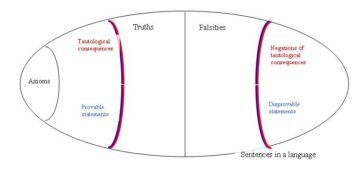 Since logic is the ultimate go-to discipline for determining whether deductions are valid, one might expect basic logical principles to be indubitable or self-evident – so philosophers used to think. But in the past century, every principle of standard logic was rejected by some logician or other. The challenges were made on all sorts of grounds: paradoxes, infinity, vagueness, quantum mechanics, change, the open future, the obliterated past – you name it. Many alternative systems of logic were proposed. Contrary to prediction, alternative logicians are not crazy to the point of unintelligibility, but far more rational than the average conspiracy theorist; one can have rewarding arguments with them about the pros and cons of their alternative systems. There are genuine disagreements in logic, just as there are in every other science. That does not make logic useless, any more than it makes other sciences useless. It just makes the picture more complicated, which is what tends to happen when one looks closely at any bit of science. In practice, logicians agree about enough for massive progress to be made. Most alternative logicians insist that classical logic works well enough in ordinary cases. (In my view, all the objections to classical logic are unsound, but that is for another day.)
Since logic is the ultimate go-to discipline for determining whether deductions are valid, one might expect basic logical principles to be indubitable or self-evident – so philosophers used to think. But in the past century, every principle of standard logic was rejected by some logician or other. The challenges were made on all sorts of grounds: paradoxes, infinity, vagueness, quantum mechanics, change, the open future, the obliterated past – you name it. Many alternative systems of logic were proposed. Contrary to prediction, alternative logicians are not crazy to the point of unintelligibility, but far more rational than the average conspiracy theorist; one can have rewarding arguments with them about the pros and cons of their alternative systems. There are genuine disagreements in logic, just as there are in every other science. That does not make logic useless, any more than it makes other sciences useless. It just makes the picture more complicated, which is what tends to happen when one looks closely at any bit of science. In practice, logicians agree about enough for massive progress to be made. Most alternative logicians insist that classical logic works well enough in ordinary cases. (In my view, all the objections to classical logic are unsound, but that is for another day.)
more here.

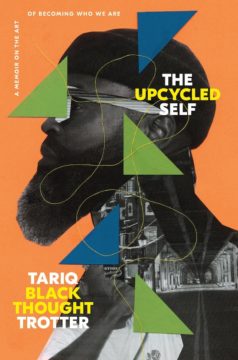 Across three decades as philosophical frontman for the Roots, Tariq Trotter (a.k.a. Black Thought) has composed such an expansive catalogue of keen social commentary and gritty introspection that his verse constitutes a biography in itself. With his memoir, “
Across three decades as philosophical frontman for the Roots, Tariq Trotter (a.k.a. Black Thought) has composed such an expansive catalogue of keen social commentary and gritty introspection that his verse constitutes a biography in itself. With his memoir, “